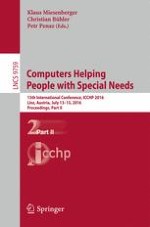2016 | OriginalPaper | Chapter
Development and Evaluation of Navigation System with Voice and Vibration Output Specialized for Persons with Higher Brain Dysfunction
Authors : Akihiko Hanafusa, Tsuyoshi Nojiri, Tsuyoshi Nakayama
Published in: Computers Helping People with Special Needs
Publisher: Springer International Publishing
Activate our intelligent search to find suitable subject content or patents.
Select sections of text to find matching patents with Artificial Intelligence. powered by
Select sections of text to find additional relevant content using AI-assisted search. powered by
